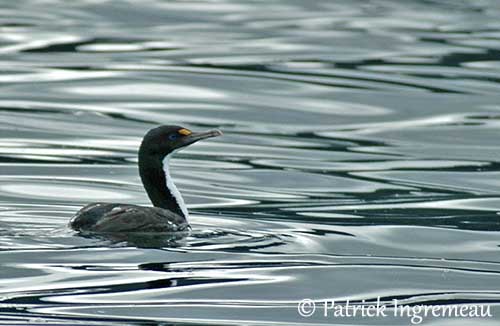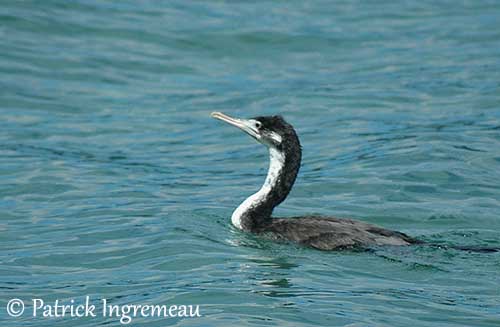
Fr: Cormoran caronculé
Ang: Rough-faced Shag
All: Warzenscharbe
Esp: Cormorán Carunculado
Ita: Marangone caruncolato
Nd: Wrattenaalscholver
Sd: Kungsskarv
Photographer:
Patrick Ingremeau
TAMANDUA
Text by Nicole Bouglouan
Sources:
HANDBOOK OF THE BIRDS OF THE WORLD vol 1 by Josep del Hoyo-Andrew Elliot-Jordi Sargatal - Lynx Edicions - ISBN: 8487334105
BirdLife International (BirdLife International)
New Zealand bird status between 2008 and 2012
New Zealand birds and birding (Narena Olliver)
Wikipedia, the free encyclopaedia
Page family Phalacrocoracidae
Summary cards
Rough-faced Shag
Leucocarbo carunculatus
Suliformes Order – Phalacrocoracidae Family
INTRODUCTION:
The Rough-faced Shag is a rare species, endemic to New Zealand. The small population is confined to four very small islands in the Marlborough Sounds area, since at least 240 years. The numbers appear stable, but the species is vulnerable to human impacts.
DESCRIPTION OF THE BIRD:
Biometrics:
Length: 76 cm
Weight: 2, 5 kg
The adult has black head and upperparts, except a white marking, patch or stripe, near the leading edge of the inner wing. There is sometimes a white patch on the upper back.
The underparts are white from chin to vent, but thighs are black with green to bluish gloss.
The head appears very dark with black extending to just under the bill.
In breeding plumage, the adult has warty yellow caruncles on each side of the base of the upper mandible. These caruncles are duller and reduced outside the breeding season. There is also a short black crest on the crown, often held flat, but sometimes visible in breeding period. It is absent outside the breeding season.
The long, thick bill is greyish to flesh-horn with darker culmen. The eyes are dark brown, surrounded by conspicuous cobalt-blue eyering, usually duller outside breeding. Legs and webbed feet are pink.
The juvenile resembles non-breeding adult but it has browner upperparts and paler facial skin.
RANGE:
The Rough-faced Shag is found in the outer Marlborough Sounds, in a small area in NE South Island. There are four breeding sites, Trio Islands, Duffers Reef, White Rock and Sentinel Rock.

HABITAT:
The Rough-faced Shag breeds on rocky islets, on flat ground or steep slopes, and rocky ridges. They roost on bare rocks.
It forages in coastal waters, usually in sheltered areas such as bays and inlets.
CALLS AND SONGS:
The Rough-faced Shag is mainly vocal in the early morning. It produces low frequency sounds and croaking.
BEHAVIOUR IN THE WILD:
The Rough-faced Shag feeds on marine preys, mainly flat fish species, and probably crustaceans too.
This species dives at depths of 20-50 metres. It catches its preferred preys on the bottom where they are living. It forages in the deeper waters of the Marlborough Sounds.
They may sometimes form small feeding flocks.
With so inaccessible breeding areas, courtship and nesting behaviour of the Rough-faced Shag is poorly known. We can suggest that courtship displays are similar to those of other “pink-footed shags” becoming more vocal and adopting postures which enhance head and wing patterns. They are monogamous and colonial breeders.
The Rough-faced Shag is sedentary. The birds forage to W, S and SE of their colonies, but the direction also depends on the winds.
Shags are good fliers and perform powerful, regular, continuous wingbeats.

REPRODUCTION OF THIS SPECIES:
The breeding season occurs between March and December, with the laying in May-June.
The Rough-faced Shag breeds in colonies of up to 80 pairs, established on rocks on small islets or stacks. The nests are spaced one metre apart.
The nest is a platform made with sticks and seaweeds, cemented together with excreta.
The female lays 2-3, but often 2 whitish to pale blue eggs. The incubation is unknown, but probably lasts 23-35 days.
At hatching, the chicks are naked, but they are quickly covered with smoky-brown down. They are fed by both parents which leave the nest at dawn for foraging, and return at the colony around midday. The chicks are fed by regurgitation.
PROTECTION / THREATS / STATUS:
The Rough-faced Shag has very restricted range and small population estimated at about 645 individuals. Numbers appear stable for at least 50 years.
Like numerous seabirds, they are threatened by oil pollution, disturbances at colonies and fishing nets close to the breeding sites.
The Rough-faced Shag is considered as Nationally Endangered in New Zealand, and globally classified as Vulnerable.